What Is The Best Bass Fishing Rod And More!...
There comes a time when an angler starts to get serious about bass fishing and you quickly realize that owning your uncles old hand-me-down rod from the 1970’s just won’t cut it.
Are you still wondering what is the best rod for bass fishing? Here’s your quick and easy answer! The best rod for bass fishing depends on the technique you’re going to use so you can catch bass fast and avoid spending countless unproductive hours on the lake!
Key Takeaways
For most anglers you can get away with using only 3 rods. We recently performed a poll asking over 4000 anglers how many rods do you need to carry, and what types of rods should they be? … The results surprised us.
- The first rod is a casting rod, approximately 7’6″, medium heavy action, fast tip – Use this for your heavier baits such as larger jigs, frogs, crankbaits, flipping and pitching baits.
- The second rod needs to be a casting rod, approximately 6’8″, medium, extra fast tip – Use for lighter baits such as smaller topwater poppers, walking baits, lighter Texas rigs, smaller jigs and lures.
- And finally, a spinning rod, approximately 7’8″, medium action, extra fast tip – Use this rod for finesse style presentations such as drop shot, mojo rig, neg rig, ect.
In today’s post, we’ll provide more information on the three rods you need to have to get started bass fishing, including real examples from your favorite fishing rod brands and models.
We’ll also discuss how to some common frequently asked bass fishing questions. You’re not going to want to miss it!
How many rods to have for bass fishing?
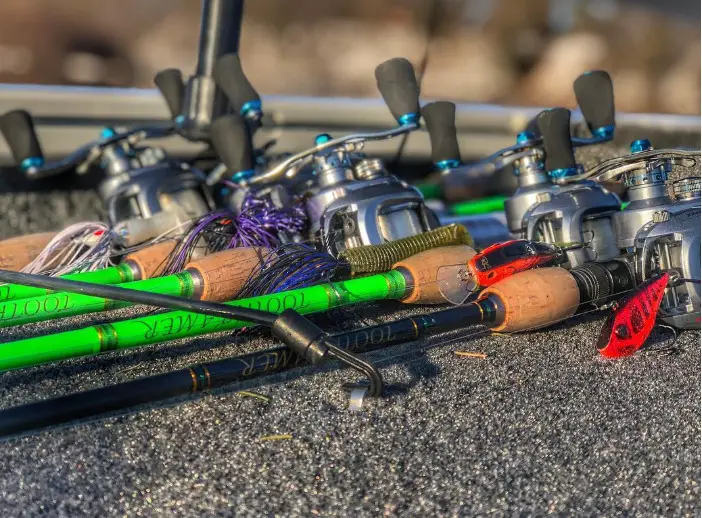
I’m sure you’ve seen the videos or know someone who has 12+ rods on the deck of their boat and they’re practically tripping over them during their day of fishing.
But I’m here to tell you the average bass fisherman does not need 10-12 rods to have a successful day on the water…
Yes, eventually you may want to consider branching out to test the waters and try a niche specific rod. But you don’t need it, especially if you’re just starting out.
So this is what we did…
Our team has a combined 75 years of fishing experience and we had a fun discussion (with some frosty beverages included) and we came to firm conclusion…
A bass angler only requires 3 specific styles of rods.
By the way, you don’t need the most expensive rods either. Most manufacturers will make a quality rod for every budget.
Then we ran a poll on multiple groups and forums… and by the end we had well over 4000 anglers answer what types of rods they think are the most important to start out with.
Here are those results… and the conclusion was startling!…
1) Casting rod, medium-heavy action, fast tip – Use this for your heavier lures. Beefier lures such as you fast moving “reaction” baits including: buzzbaits, frog lures, chatterbaits, heavier deeper diving crankbaits, larger soft plastic swimbaits, umbrella rigs, swim jigs, hair jigs, and including flutter spoons. You can also use this rod for your slower fished lures such as larger jigs, flipping and pitching baits, heavier Texas rigs, and Carolina rigs.
2) Casting rod, medium light, extra fast tip – This style of rods is considered to be the best bass fishing rod for lighter weight baits. Reaction baits such as smaller topwater lures (like poppers or small walking baits), smaller soft plastic swimbaits, swim jigs, crankbaits, lipless crankbaits, spinnerbaits, underspin jigs or chatterbaits. Similarly, this style of rod is versatile enough to fish slower moving lures such as a wacky rig Senko, Mojo rig, Texas rig, weedless tubes, or even a drop shot rig.
As you can plainly see… these 3 rods have you covered for most techniques of fishing.
Lets begin by diving by discussing the different styles of rods suggested you carry…
In A Hurry?
If you don’t have much time to read the details we totally understand. Simply use the links below to quickly find the best rods for your bass fishing needs on Amazon. You can be assured we only choose the best products…
Best Medium-Heavy Casting Rod – Click HERE to learn more!
Best Medium-Light Casting Rod – Click HERE to learn more!
Best Finesse Spinning Rod – Click HERE to learn more!
I want to learn more about…
Click on the links below to fast travel to the different parts of the post to learn more about the rods that interest you the most.
Medium-Heavy Casting Rods
Medium-Light Casting Rods
Finesse Spinning Rods
Rod Style 1) Medium-Heavy Casting Rods
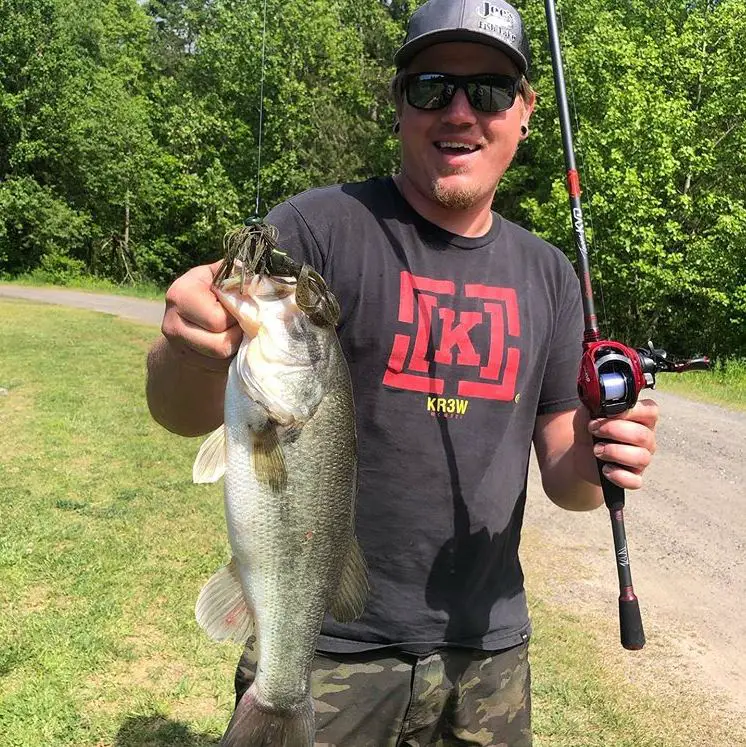
photo @po_boi_outdoors
Since you’re just getting started, the first rod you’ll want to invest in would be a medium-heavy casting rod, 7’3″ to 7’8″ long, with a fast action tip.
You’ll probably do most of your fishing with this rod, so it’ll be the workhorse getting the most use.
The best bass fishing rods for heavier baits need a little heavier power, a little longer, and should have a very sensitive tip.
It’s an interesting combination.
Having a strong backbone will also allow you to move the heavy lure and set the big hook with ease.
The fast action tip will detect even the smallest of bites.
Additionally, using a longer rod aids in lure action by raising the tip of the rod. The longer the rod the more line you move when you raise the tip.
These rods are great for fishing larger jigs, frogs, skipping baits, crankbaits, flipping and pitching lures.
Not sure if you heard the phrase, big bass eat big lures – it’s true. So if you really want to catch as TON of BIG bass, you need a medium-heavy casting rod. I updated the list to include the best rods on the market. Click HERE to learn more.
Rod Style 2) Medium Light Casting Rod
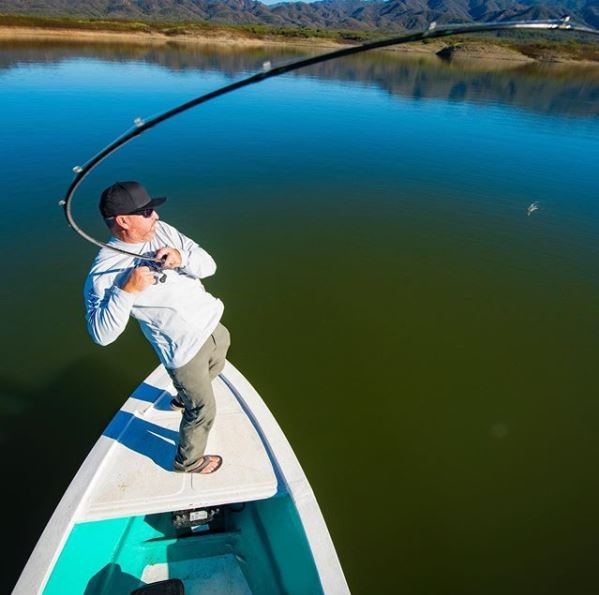
photo @simmsfishing
These rods tend to be on the shorter side 6’3″-to-6’8″, medium-light to medium power backbone paired with an extra-fast action tip.
The extra-fast action tip will allow you to cast a lighter weighted lure a mile, or cast a lure with tactical precision.
These rods come with increased flex which acts as a cushion so light-wire hooks won’t bend out.
Use for lighter baits such as smaller topwater poppers, walking baits, lighter Texas rigs, smaller soft plastic swimbaits on light jig heads or weighted swimbait hooks, Senko baits, and other smaller jigs and lures.
This rod will probably act as your topwater rod in the morning. Then as the sun rises and the topwater bite dies off rig on a smaller lure sub-surface lure.
Rod 3) Finesse Spinning Rod
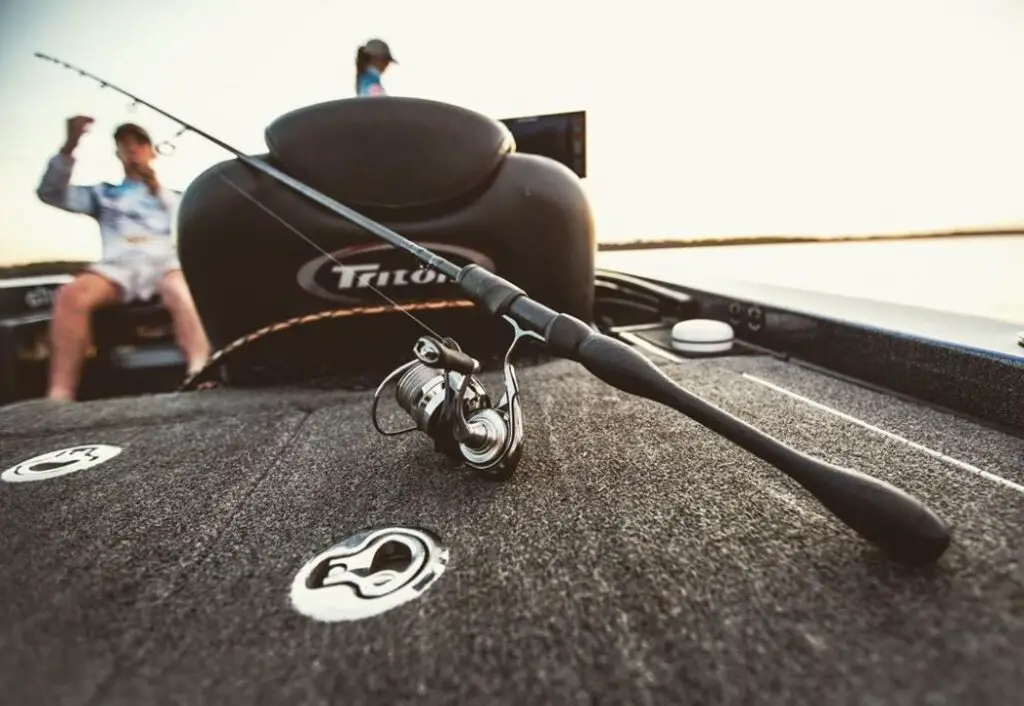
photo @stephenk22
Spinning rods in bass fishing are primarily (but not always) designed around more finesse applications. They are on average lighter, more sensitive, and have a hand feel that is more comfortable than using a baitcasting rod.
Most of the best bass fishing rods used for finesse fishing will be 6’8″ to 7’3″. Having a longer rod will allow you to cast a lightweight rig farther and even into the wind.
Having a longer rod will give you the ability to move, lift, and drag your finesse rig over or around certain pieces of structure.
What Makes A Good Rod For Bass Fishing?
The Specs
After deciding the type of rod we need to tackle the length question, how long or short do you want for a rod? There are specific times when you want or need shorter or longer rods and we will get into that later.
Most anglers will prefer a seven-foot rod for most of my applications. It really allows you to get a good cast, a stronger hookset, and excellent control of the fish when hooked. In addition, by having most rods the same length, it will be easier adjusting when you have different rods with different lures tied on.
However, there are some instances when the rod you’re using needs to either be shorter or longer.
The next important thing to consider is the power rating.
The Power
Have you heard the person in the fishing section talking about how they “set the hook with their extra heavy jig rod and the monster didn’t even budge”?
Most likely because he just hooked a stump, but let us focus on the “extra heavy” part of the jig rod. Fishing rod manufacturers separate rods by the power, for example, ultra-light, light, medium, medium-heavy, heavy, extra-heavy.
These designations represent the strength of the rod. This information can usually be found written on the rod near the handle and use abbreviations like UL, L, M, MH, H, XH.
Along with the power rating, you have to think about the action of the tip.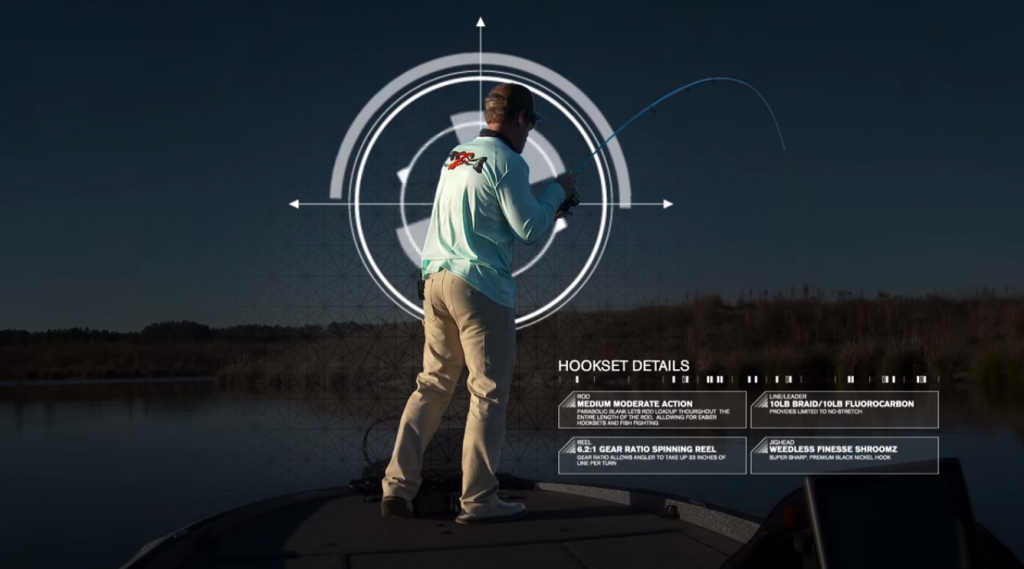
“Tip Action”
Tip-Action will vary from rod to rod and manufacturer to manufacturer, however, a “fast action tip” is just that.
There are a few different types of action to rods. This action refers to how much movement the tip of the road has.
Most basic actions are medium, fast, and extra fast.
Each action has a different purpose, for example, if you were fishing a finesse bait on light line, then an extra fast tip to helps to set the hook without putting too much pressure on the line itself.
If you have too stiff of a tip then you could rip the hook out of the fishes mouth when setting the hook too hard.
The action also helps in the motion of the lure in certain circumstances…
Throwing a jerk bait might be better suited on a fast action rod rather than a medium action tip.
So now that we have covered some of the “basics” of rods, it is time to get into the nitty-gritty of technique-specific rods.
My Private Notes
 I have used so many rods over the years and it is my personal experience here are so many different technique-specific rods that you could use… and… there could almost write an entire chapter on all of them.
I have used so many rods over the years and it is my personal experience here are so many different technique-specific rods that you could use… and… there could almost write an entire chapter on all of them.
However for your sanity and mine, lets limit the discussion of a casting rod to a few paragraphs.
Casting rods
Casting rods are usually stiffer than a spinning rod and made from either graphite, fiberglass, or a combination of the down.
Fiberglass has a usually more moderate or slower action to it. Fiberglass rods are heavier and less sensitive though, they can wear out your arm or shoulder throwing it all day.
Graphite rods allow for more sensitivity and weigh far lighter than fiberglass, which helps when you are throwing it around a lot searching for those bass.
Many anglers prefer slightly longer rods for reaction baits, it allows me to cast further and cover more water.
Casting rods are great for accurate long casting, and fishing heavier lures. They are also great for fighting big fish embedded deep in thick vegetation without the fear of the rod breaking.
Casting rods are therefore heavier than spinning rods.
Casting rods also need a specialized reel called a casting reel in order for it to function correctly.
Spinning rods
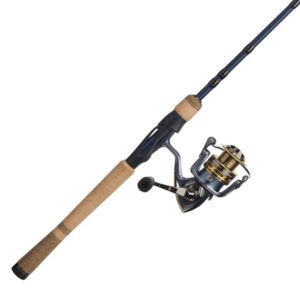
Most spinning rods are designed for more of a finesse approach to fishing, yes they do make and sell monster spinning rods; those are usually for saltwater or catfishing.
Bass spinning rods are usually between six feet and seven feet for length and have a power rating of medium or less. The action is most likely fast or extra fast, but occasionally medium.
Spinning rods are made for light line, light lures and finesse tactics. They are mostly ultra-sensitive and you can feel almost everything with them. So these are typically used for drop shot, weightless stick baits, topwater floating worms, which all serve a great purpose when bass fishing.
The manufacturers may designate this style of rod as either a drop shot rod, or a finesse rod.
Finally, spinning rods require a special reel called a spinning reel in order for it to function correctly.
FAQ
Can broken fishing rods be repaired
Yes, even the best bass fishing rod can break clean through and crushed, but they can be fixed pretty easily .
- Start by dry sliding the large end over the smaller end. You may need to lightly sand down the smaller end first.
- Then once you can dry slide the two pieces together, simply mix up some 2-part epoxy adhesive.
- Coat the small end and slide the larger end over it. Make sure you line up the two ends.
- Wipe off any excess.
- Allow epoxy to cure for 24-hours.
Can fishing rods be carried on a plane?
According to the TSA, “Fishing rods are permitted in carry-on and checked bags; however, passengers should check with the airline to confirm that the fishing rod fits within size limitations for carry-on items.”
Can fishing rods get wet?
Yes they can. The vast majority of fishing rods get wet without any damage. However, if you have line guides that are scratched or have exposed metal and are saltwater fishing the saltwater may cause them to corrode. But the actual rod will be just fine.
Are fishing rod holders illegal?
Fishing rod holders that are carried to a fishing spot either attached to your boat, kayak, or carried and placed on the ground are not typically illegal.
However, fishing rod holders that you attach to the outside of your car or truck to hold your rods could be. Many police organizations say that in the event of an accident the rod could break, creating a pointed end, and could cause bodily injury to any pedestricans. Please check your local and state laws for more information.
What makes a good bass fishing reel?
It really comes down to three main components that make up a good fishing reel for bass fishing. Those are the drag, the bearings, internal gearing, and designated use.
If you want to protect your investment buy the right gear and it will last you years to come.
But this is just the tip of the iceberg! There are other factors you must know to choose a good bass fishing reel based on the technique you’re planning to use it on. Luckily I wrote an in depth report on all the different styles of reels, what applications they perform the best in and what should be avoided.
Read more: How To Choose A Reel For Bass Fishing [2024]
What color line for bass fishing?
It is still unknown if bass can see different color lines. It is known that bass do pick up shades of red, green, and grey. Some lines such as green braided line will blend into the environment if it’s used in an area that holds vegetation.
However, it will stick out like a sore thumb if it’s used in clear water conditions. Fluorocarbon line will actually absorb sunlight and therefore render itself invisible.
Unfortunately, if the line gets any nicks or scrapes the fish will easily see the imperfection and could be spooked. Monofilament lines can appear shiny underwater and reflect the sunlight. It’s generally not recommended when you need a stealthy delivery.
Read more: 21 Tips To Choose The Best Bass Fishing Line
Does unused fishing line go bad?
Yes it does. Braided line can last years because of its thread-like construction. However, fluorocarbon and monofilament should be changed every year because they will dry out, become brittle, lose knot strength, and will be prone to breaking. If you’re going to store your line it’s best if you store it indoors in a dark environment.
Read more: Bass Fishing Line Tips To Catch You More Fish – FAST!
What baits are best for bass fishing?
The best baits should cover these three applications of bass fishing: topwater, tight-line (fast) applications, and slack-line (slow) applications. If you make sure you have at least some baits that cover those key areas of bass fishing you should be fine.
You may be asking yourself what are some good lures that I could use year-round? Fortunately, I created a report that addresses that specifically. Click the link below to learn the secrets.
Read more: What Are The Top 5 Bass Lures?
How to determine water clarity for fishing?
The way you can tell the water clarity is by measuring the distance that you can see a bright object like a bright white spinnerbait or an actual tool called a Secchi disc. Depending on when you cannot see the object anymore will tell you the water clarity.
From there, you can quickly choose the lures that will have the best probability of catching fish.
Read more: Water Clarity Guide for Bass Fishing [Blueprint Revealed]
Is there a water clarity chart for fishing?
Yes, there sure is. I just happen to make such a chart to help myself and other thousands of anglers like yourself. Click here to check it out.
Which is better? Tacklebox or tackle bag?
In the beginning, fishermen were forced to use tackle boxes which were heavy, uncomfortable to transport, but we’re also prone to tipping over on uneven surfaces, resulting in spilled tackle all over the ground.
Then tackle bags hit the scene, with thousands of anglers every year quickly realizing the benefits of owning a tackle bag.
The perfect tackle bag gives the fishermen a portable and effective organizational system that creates a complete balance between efficiency, mobility, and comfort.
Read more: Best Tackle Bag for Fishing [Test & Review Guide]
Getting Started With Bass Fishing? Read These Articles First...
- How To Catch Bass – 57 Fool-Proof Methods To Start Bass Fishing [Made Easy!]
- 5 Best Bass Baits Every Angler Must Own (Are You Missing Out?)
- Best Bass Fishing Lures 2024: Comprehensive Buyers Guide
- Bass Fishing Rod Secrets: Helps You Chose The Right Type Of Rod Faster!
- 21 Tips To Choose The Best Bass Fishing Line
- WARNING: Don't Even Think About Trying To Buy Your Fishing Reel Until You Read This...
- Water Clarity Guide for Bass Fishing [Blueprint Revealed]
- Top Secret! Catch Bass From the Bank Every Time
- 25 Night Bass Fishing Tips and Tricks
More articles just for you...
Funny Fishing Rules, Laws, and Regulations 2025
Crazy Fishing Laws That Will Blow Your Mind! #7 is INSANE! Strange Fishing Regulations and Laws As silly as hook and rod limits may seem,
EXPOSED! How To Use A Spinnerbait The Right Way for 2025
Are You Wondering How To Use A Spinnerbait? Or How To Work A Spinnerbait Over Grass, Logs, or Points? Well, All These Questions Are Answered
EXPOSED! Best Crankbait Colors for 2025 [Which to Buy & Avoid]
What color crankbait to use? Crankbait Color Chart I just love going into a Bass Pro Shops store and just staring at all the walls
Best Underwater Dock Lights For Fishing – 2025 Buyers Guide
Night Dock Light Fishing For Beginners Dear fellow angler, Does this sound like you? You’re someone who loves fishing but just wants to escape the
15 Best Deep Diving Crankbaits [2025 Buyers Guide – Which to Buy & Avoid]
A Complete Buyer’s Blueprint On The Best Deep Diving Crankbaits for Bass, Walleye, or Striped Bass On The Market Today Fishing deep diving crankbaits can
Source [*]
